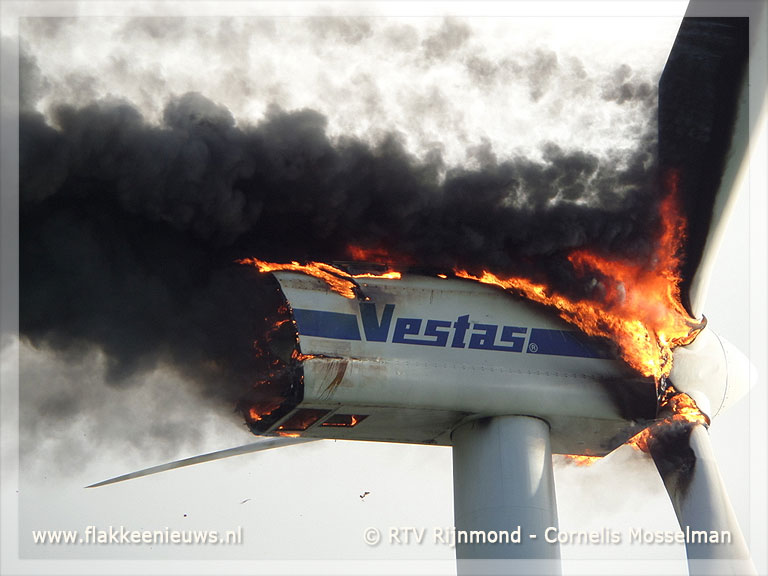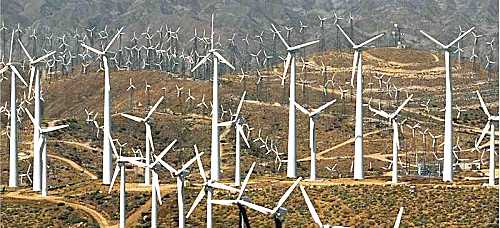This (lightly edited) article reveals sensational facts about the “clean, renewable, inexpensive” wind generation being forced on us by dreaming greenies and spineless politicians. With solid, pragmatic engineering expertise it destroys the grounds cited by our Minister for Climate Change, James Shaw, and the bureaucrats of the Ministry for the Environment who would transform our economy to “zero carbon,” a ridiculous (and undefined) policy which could be recommended only when labouring under zero knowledge of the climate (but of course: “zero carbon” = zero knowledge). Knowing the facts set out below, there’s no defence for a national policy of “decarbonisation”, since there’s categorically no reliable replacement for fossil fuel-powered electricity generation to be found in windmills. The article was originally posted under the title “Electricity consumption in wind turbines” in about 2004 by Eric Rosenbloom, a science editor and writer (then) living in Vermont. There’s more information at his website and in his post A Problem With Wind Power (scroll to the bottom for lots of links). — h/t Susan Goodman for a comment at WUWT
— RT
Energy consumption in wind facilities
Large wind turbines require a large amount of energy to operate. Other electricity plants generally use their own electricity and the difference between the amount they generate and the amount delivered to the grid is readily determined. Wind plants, however, use electricity from the grid which does not appear to be accounted for in their output figures. At the facility in Searsburg, Vermont, for example, it is apparently not even metered and is completely unknown*. The manufacturers of large turbines — for example, Vestas, GE and NEG Micon — do not include electricity consumption in the specifications they provide.
Windmills draw power from the grid the whole time
Wind turbine functions that use electricity include:†
- Yaw mechanism (to keep the blade assembly perpendicular to the wind, also to untwist the electrical cables in the tower when necessary) — the nacelle (turbine housing) and blades together weigh 92 tons on a GE 1.5-MW turbine.
- Blade pitch control (to keep the rotors spinning at a regular rate).
- Lights, controllers, communication, sensors, metering, data collection, etc.
- Heating the blades — this may require 10%-20% of the turbine’s nominal (rated) power.
- Heating and dehumidifying the nacelle — according to Danish manufacturer Vestas, “power consumption for heating and dehumidification of the nacelle must be expected during periods with increased humidity, low temperatures and low wind speeds.”
- Oil heater, pump, cooler and filtering system in gearbox.
- Hydraulic brake (to lock the blades in very high wind).
- Thyristors (to moderate the connection and disconnection between generator and grid) — 1%–2% of the energy passing through is lost.
- Magnetizing the stator — the induction generators used in most large grid-connected turbines require a “large” amount of continuous electricity from the grid to actively power the magnetic coils around the asynchronous “cage rotor” that encloses the generator shaft. At the rated wind speeds, it helps keep the rotor speed constant, and as the wind starts blowing it helps start the rotor turning (see next item). In the rated wind speeds, the stator may use power equal to 10% of the turbine’s rated capacity, in slower winds possibly much more.
- Using the generator as a motor to help the blades start to turn when the wind speed is low or, as many suspect, to maintain the illusion that the facility is producing electricity when it is not,‡ particularly during important site tours or noise testing (keeping the blades feathered, i.e., quiet). It seems possible that the grid-magnetized stator must work to help keep the 40-ton blade assembly spinning, along with the gears that increase the blade rpm some 50 times for the generator, not just at cut-in (or for show in even less wind) but at least some of the way up towards the full rated wind speed; it may also be spinning the blades and rotor shaft to prevent warping when there is no wind§.
Could it be that at times each turbine consumes more than 50% of its rated capacity in its own operation? If so, the plant as a whole, which may produce only 25% of its rated capacity annually, would be using (for free!) twice as much electricity as it produces and sells. An unlikely situation perhaps, but the industry doesn’t publicize any data that proves otherwise; incoming power is apparently not normally recorded.
Is there some vast conspiracy spanning the worldwide industry from manufacturers and developers to utilities and operators? There doesn’t have to be, if engineers all share an assumption that wind turbines don’t use a significant amount of power compared to their output and thus it is not worth noting, much less metering. Such an assumption could be based on the experience decades ago with small DC-generating turbines, simply carried over to AC generators that continue to metastasize. However errant such an assumption might now be, it stands as long as no one questions it. No conspiracy is necessary — self-serving laziness is enough.
 If wind really worked, they’d trot out real numbers
If wind really worked, they’d trot out real numbers
Whatever the actual amount of consumption, it could seriously diminish any claim of providing a significant amount of energy. Instead, it looks like industrial wind power could turn out to be a laundering scheme: “Dirty” energy goes in, “clean” energy comes out. That would explain why developers demand legislation to create a market for “green credits” — tokens of “clean” energy like the indulgences sold by the medieval church. Ego te absolvo [I absolve you].
(One need only ask utilities to show how much less “dirty” electricity they purchase because of wind-generated power to see that something is amiss in the wind industry’s claims. If wind worked and were not mere window dressing, the industry would trot out some real numbers. But they don’t. One begins to suspect that they can’t.)
*Wayne Gulden has analyzed the daily production reports of a Vestas V82 1.65-MW wind turbine at the University of Minnesota, Morris, from 2006 to 2008. Those records include negative production, i.e., net consumption, as well as daily average wind speeds. The data suggest that the turbine consumes at a minimum rate of about 50 kW, or 8.3% of its reported production over those years (which declined 2-4% each year).
Windmills draw a lot of power at startup
There is also the matter of reactive power (VAR). As wind facilities are typically built in remote areas, they are often called upon to provide VAR to maintain line voltage. Thus much of their production may go to providing only this “energy-less” power.
See also: “Tehachapi’s four turbines may be scuttled,” Gordon Lull, Nov. 7, 2012: “[N]ow some question whether the turbines actually cost more money, in terms of electricity usage and maintenance expenses, than they generate in power.” … “[T]he turbines themselves, intended as renewable energy generators, must draw significant amounts of electricity from traditional non-renewable sources when being started.”
†Much of this information comes from a Swedish graduate student specializing in hydrogen and wind power posted in a Yes2Wind discussion. Also see the Danish Wind Industry Association’s guide to the technology. The rest comes from personal correspondence with other experts and from industry spec sheets.
‡An observer in Toronto, Ontario, points out that the blades of the turbines installed at the Pickering nuclear plant and Exhibition Place turn 90% of the time, even when there is barely a breeze and when the blades are not properly pitched, in a region acknowledged to have low wind resource.
§In large rotating power trains such as this, if allowed to stand motionless for any period of time, the unit will experience “bowing” of shafts and rotors under the tremendous weight. Therefore, frequent rotating of the unit is necessary to prevent this. As an example, even in port Navy ships keep their propeller shafts and turbine power trains slowly rotating. It is referred to as “jacking the shaft” to prevent any tendency to bow. Any bowing would throw the whole train out of balance with potentially very serious damage when bringing the power train back on line.
In addition to just protecting the gear box and generator shafts and bearings, the blades on a large wind turbine would offer a special challenge with respect to preventing warping and bowing when not in use. For example, on a sunny, windless day, idle wind turbine blades would experience uneven heating from the sun, something that would certainly cause bowing and warping. The only way to prevent this would be to keep the blades moving to even out the sun exposure to all parts of the blade.
So, the point that major amounts of incoming electrical power is used to turn the power train and blades when the wind is not blowing is very accurate, and it is not something the operators of large wind turbines can avoid.
[Also, there is] the likely need for a hefty, forced-feed lubricating system for the shaft and turbine blade assembly bearings. This would be a major hotel load. I can’t imagine passive lubrication (as for the wheel bearings on your car) for an application like this. Maybe so, but I would be very surprised. Assuming they have to have a forced-feed lubrication system, given the weight on those bearings (40 tons on the bearing for the rotor and blades alone) a very robust (energy-sucking) lubricating oil system would be required. It would also have to include cooling for the oil and an energy-sucking lube oil purification system too.
— Lawrence E. Miller, Gerrardstown, WV, an engineer with over 40 years of professional experience with large power train machinery associated with Navy ships.
Also: ‘The wind farm operator … has to keep the sensitive equipment — the drives, hubs and rotor blades — in constant motion …’ (The Automatic Earth, Oct. 27, 2012)

Views: 255

RIP Dr Dave Kear, Geologist, True Sceptic, Co-discoverer of the “Kear-Marshall Line, describing the actions of descending mantle and how it was distilled into Basalt volcanoes after forming shallower Rhyolite ones. As here in Northland at about 40 miles separation. One of our Giants of Science, incorruptible unlike certain geographers etc..
Thankyou Dave, from Brett
Hi from Oz,
We too have an infestation of both small and large scale solar and wind ‘generators’ killing wildlife and creating widespead visual pollution.
We also have the Large Scale Renewable Energy Target legislation which via a cunning set of requirements simultaneously does several things to damage our previously efficient and reliable power system.
It provides a hidden 100% subsidy (approximately A$90/megawatthour, or roughly the same as the current wholesale cost of electricity here) to renewables generators for every megawatt hour they send to the grid;
it mandates that power retailers must currently buy some 18-20% of their demand from renewables generators and buy one of these certificates for each mwh;
baseload (‘fossil-fuel’) generators must curtail their output in favour of renewables generators as required;
and finally retail customers have the cost of these certificates added to (but not itemised) their electricity bills. Do you kiwis have a similar sneaky subsidy system?